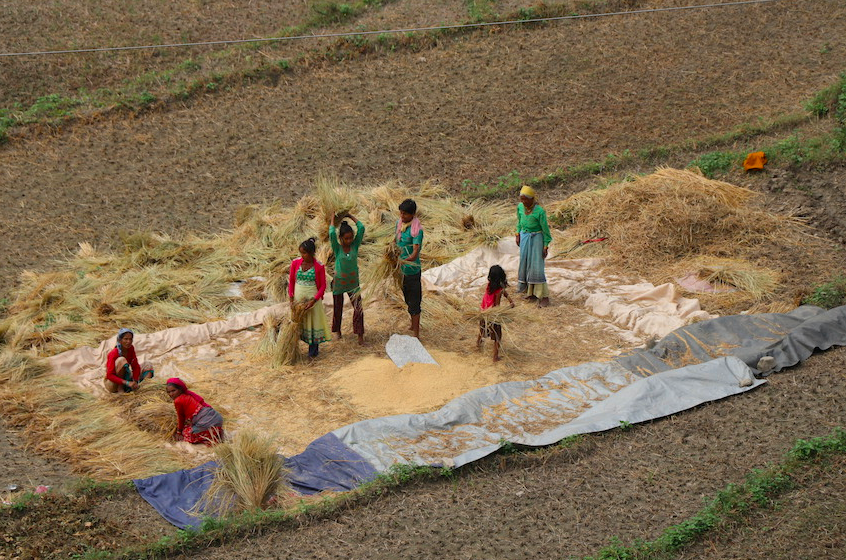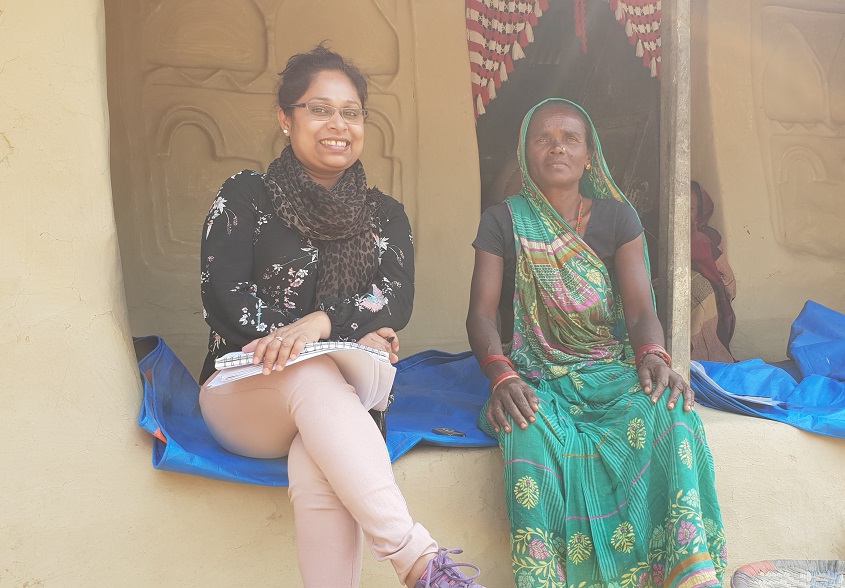by Claire Swingle
Today is International Migrants Day. Food and migration are often thought of together, mostly in the ways that migrants bring culinary traditions and flavors with them to new places, and the hodgepodge of delicious restaurants in areas with high immigrant populations. But food, especially food insecurity, is also a key reason why people migrate. This is true in Nepal, where rice is both central to food and cultural identity and also the face of food insecurity and a changing society.
“Dal bhat khaanu bhayo?” (have you eaten dal bhat yet?) is an equivalent greeting to “how are you?” after all, and for good reason, since the lentil soup and rice dish is eaten at all times of day throughout the country. Rice keynotes important ceremonies that bookmark one’s life, too, from Annaprasana – celebrating the first time a baby eats solid food – to Antyesti, Hindu funeral rites where rice balls are offered to ancestors. Despite the ubiquity of bhat (known as chamala before it is cooked)in the most quotidian and the most sacred events in Nepali life, rice, and the socio-cultural traditions that surround its cultivation, is also part of the driving forces behind migration.
Male out-migration, the so-called “feminization of agriculture,” is stark in many rural areas, where rising input costs, deeply ingrained caste and gender inequalities, and decreasing plot sizes, compounded by climate-change induced stresses and risks, has led to many men migrating either seasonally or full-time for work, primarily to India and the Middle East. Indeed, remittances make up almost a third of the Nepali economy.[1]
Improving food security can be a powerful tool for reducing the push factors that force migration. Improving water use for dry season agriculture by marginal and tenant farmers (DSI4MTF)[2] is one project working in the Eastern Gangetic Plains, which include the Nepal Terai as well as Bihar and West Bengal, to improve the resiliency of small and marginal farmers.
In the mountains, grains such as millet, barley, and buckwheat have been long been traditionally cultivated but are now being largely disregarded in favor of rice — despite it having fewer nutrients than the other grains, and being less suited to the marginal lands and harsh mountain growing conditions — because “bhateeys” (rice eaters) are considered more elite. The traditional recipes made from those grains, such as kaguno kheer, a sweet porridge made of millet, are also losing popularity. Nepal has gone from exporting rice (until the mid-1980s) to importing millions of rupees of rice every year, while chronic malnutrition remains a widespread concern.
Meanwhile, in the Terai lowlands in the south, Nepal’s “grainbowl,” growing rice is deeply ingrained. Accompanying this traditional cultivation are the equally entrenched challenges of limited irrigation, limited land ownership for a large portion of the (poorer, lower caste) population, and land fragmentation.
The majority of rice land in Nepal is rain-fed, which is to say completely dependent on the increasingly erratic rainfall and changing weather patterns. Farmers in the Terai primarily cultivate rice in monsoon season and maybe lentils or potatoes with the residual moisture during winter season, and then leave land fallow the rest of the year because they have limited access to water to irrigate. Any delay in monsoonal onset has a huge impact on rice yield itself, and also disrupts the other crop rotations, which are reliant on remaining moisture in soil and surface water canals. This portends challenges for food and income security, and makes access to vegetables especially precarious since they are primarily grown in summer, when fields are often forced to remain fallow due to lack of water.
This system of agriculture is not enough to meet food and income requirements for many farmers in the Terai, like Md. Sakruddin, who then have to work as wage laborers or seasonal migrant workers to make up the shortfall. Prior to joining an agricultural collective as part of the DSI4MTF project, Md. Sakruddin was a landless tenant farmer cultivating paddy, wheat, and lentil on a sharecropping basis, meaning that the land owner did not provide any input support and received 50% of the total crop yield. He then worked as a wage laborer to meet his family’s remaining needs. With project assistance, he has joined a collective, gained access to irrigation technology and a fixed-cash land lease, and has started cultivating okra and mung bean during summer season. He is able to produce enough food for his family and can even sell some produce to meet his family’s cash needs.

Md. Sakruddin and a staff member from the local NGO, Sakhi, survey his field. (PC: Anoj Kumar / IWMI)
In Nepal, demand for rice is relatively new in the mountains, while cultivation of rice is deeply ingrained in the southern Terai; yet, in both places, rice is the face of a contestation between traditional cultivation methods, crops, and class, whether because it is usurping demand for traditional local grains, or continuing entrenched systems of agriculture that are increasingly difficult to sustain in the face of increasing climatic stresses. Certainly, crop diversification will be critical for increasing incomes and supporting livelihoods, promoting climate change resiliency, enhancing nutrition, and improving water efficiency. If these conditions are not met, migration often becomes the only option. In this context, I wonder if Nepalis will still ask, “have you had your daal bhat yet?” in the same way in the coming decades.








